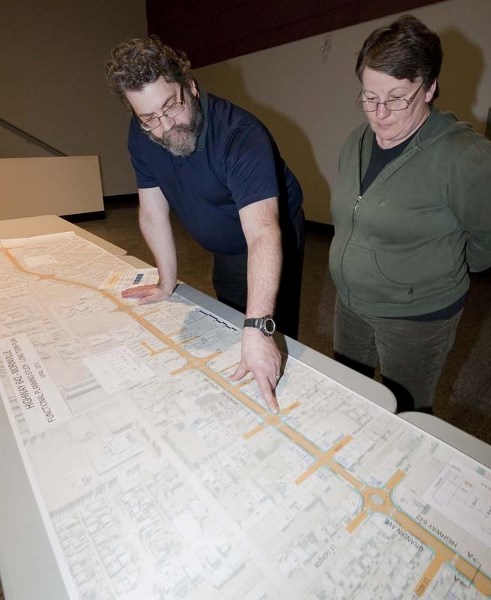Town residents were skeptical last week about the plans for the future of Morinville's main street – a future that was all about roundabouts.
About 48 people came to the Morinville Community Cultural Centre on April 25 for an open house on the Highway 642 Functional Planning Study. The plan had been shown to town council on April 23.
A joint initiative of the town and the province, the plan is meant to set out how Hwy. 642 will look in about 75 years, and is closely tied to the Coeur de Morinville downtown area structure plan.
Hwy. 642 runs through the centre of Morinville and is one of the town's main streets. The plan, if approved by the province, would see seven roundabouts eventually built on it.
This plan is vital for economic development downtown, said project manager Vicki Dodge, speaking before council. Since the highway is under provincial jurisdiction, developers need both provincial and municipal approval before they can build – a cumbersome process.
Since there's no functional plan for the road in place, she continued, the province evaluates all applications based on a generic highway design that requires a 50-metre right of way (25 on each side). Since Hwy. 642 only has 30 metres of right of way (15 per side), developers have to give up an additional 10 metres of land if they want provincial approval to build. That makes many projects unfeasible, and has driven off a considerable amount of development.
The project team looked at Morinville's traffic needs in about 75 years when the town reaches 32,000 people, Dodge said, which would triple the volume of traffic on Hwy. 642.
They also did extensive community consultation, Dodge said, which produced two key priorities: reduce the speed on the road and preserve as much on-street parking as possible.
The team found that the highway's right of way could stay at 30 metres and still handle traffic, but that seven intersections along it – 107, 104, 102 and 100 Street, Grandin Road West, Grandin Road East and East Boundary Road – would need to be upgraded.
Of the two possible upgrades – traffic lights and roundabouts – roundabouts were the winner.
Traffic lights need turning lanes, Dodge said, which means the town would have to buy a two- to seven-metre wide strip of land along most of the south side of the highway at a cost of $13.4 million to accommodate them. It would also have to shave the front sides off most of the buildings.
Roundabouts do not need turn lanes, Dodge continued, so they need less land – just $6.9 million worth. Add in construction costs, and the bill for roundabouts comes to about $16.2 million, compared to $22.6 million for lights.
They also eliminate the stop-and-go of traffic lights, Dodge said in an interview, allowing for smoother traffic flow. As they are just 39 metres wide (compared to the 100-metre ones in Edmonton), these roundabouts also force drivers to move at about 30 kilometres an hour, improving safety. "It really does reduce the speed of the travelling public."
Should Alberta Transportation approve this plan, planning and development director Greg Hofmann told council, it would speed up downtown development, as anything that complied with the plan would have de-facto provincial approval. "If there's compliance, investment occurs."
Residents skeptical
Simon Boersma, vice president of the Morinville and District Chamber of Commerce, said roundabouts would work in Morinville. "It slows down the traffic and allows people to actually look around and see what's happening in town."
It also preserves the sidewalks and parking needed to bring people to local businesses, he continued. "If the sidewalks get removed or they need that extra 10 metres … downtown's going to be decimated."
Others were more skeptical, saying that drivers barely know how to navigate a four-way stop, let alone a roundabout, or that roundabouts were dangerous in the winter.
Cheri Meunier, who owns the Morinville Shell station on 107th Ave., said in an interview that she would be out of business if the plan were approved. "The corner they want sits right above our underground tanks." The roundabout would also take out one of their pump islands and also block the north and west entrances to the station, she added.
The plan's advocates told her a roundabout would likely be built at the Shell corner within five years, Meunier said.
"This proposal would force us to close our business resulting in 23 residents being unemployed," she said. "I know part of this plan is to draw business to Morinville, but how many businesses will be lost in the process?"
She called on plan proponents to instead use a traffic light at this corner. As there was no on-street parking at that location, she said, adding a traffic light would not affect parking on the highway.
There's no guarantee that the 107th roundabout, or any of them, will be built in five years, said Dean Litke, infrastructure manager with Alberta Transportation. "It's all going to be a function of traffic volumes."
Still, said Corry Broks of Al-Terra Engineering, who worked on the project, the 107th intersection did have more traffic issues than the others. Traffic lights could be used as a short-term fix, he added.
The plan now goes to Alberta Transportation for approval. If accepted, it will then be incorporated into the town's Coeur de Morinville downtown area structure plan.



